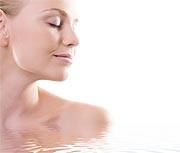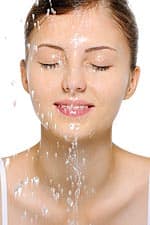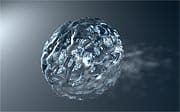Life Extension Magazine®
When you hear the words “water retention,” you probably think of feeling bloated and fat. But did you know that water retention at the cellular level is the key to younger-looking skin? Scientists have long sought new ways to increase your skin’s ability to hold water in order to combat the inevitable drying, flaking, and wrinkling that comes with age. In a remarkable development, they have recently identified a novel link between the way marine organisms and skin cells retain water in order to stay properly hydrated. The result is a spray-on moisturizing agent that combines homarine, a compound used by certain mollusks (shellfish) that protects skin cells’ from electrochemical imbalance, and erythritol, a nutrient that improves skin cells ability to hold water. Its power to restore moisture to aging skin has proven compelling in clinical trials. Among a group of women between the ages of 27 and 63, this novel moisturizer boosted water levels in surface skin cells by as much as 30%!1 The difference in physical appearance between the skin of a grape and that of a raisin is due to moisture content. This simple fact holds true for human skin as well. Keeping your skin well moisturized is a key factor in maintaining youthful appearance, softness, and flexibility.2,3 Proper hydration helps increase water content and permeability,2-10 thus leaving skin smooth and supple.2,3,11-14 Lack of adequate hydration negatively affects your skin’s natural barrier function,15 causing the premature development of fine lines and dry, sagging skin. For the majority of people, the greatest enemies of skin moisture are normal aging and cumulative sun exposure, although many other factors such as smoking, the use of alkaline cleansers, mental stress, and low environmental humidity can also play a part. Drinking plenty of water is naturally essential to maintaining proper fluid balance, but the vital importance of using a topical spray to regularly hydrate your skin cannot be stressed enough. Wetlands: A New Model for Skin HydrationIt may surprise you to learn that the flow of water in and out of estuaries (wetlands) has led to a novel strategy for keep aging skin hydrated, soft, and young-looking.
Estuaries are situated where rivers flow into the sea. They form a unique transitional zone between fresh water and saltwater marine environments. The inflow of both saltwater and freshwater provides high levels of nutrients, making estuaries among the most productive natural habitats in the world. The wide variety of fauna and flora that exist in estuary systems are well-equipped with protective strategies to ensure their survival against major variations in heat, dryness, and salinity (salt content). For instance, every 6 hours along with the tides, wetland-dwelling organisms must adjust their metabolism to the changing salt content in the water: 3.5% in sea water compared to 0.16% in freshwater. One organism in particular, a microalgae called Platymonas subcordiformis, responds to these fluctuations in salinity by altering its cell volume (water potential) and by controlling the number of elemental chemicals that actively affect water balance, including potassium, calcium, and sodium ions. The survival strategy of this single-celled alga ultimately led to a compelling model for ensuring optimal water balance in your skin. It also led to an ingredient isolated by a team of dermatologists that harnesses its power to stay optimally hydrated. A Spray-on Moisturizer from the Sea
The outer layer of your skin suffers shocks in response to heat, cold, wind, detergents, and UV radiation that dry out your skin. Like the microalgae in the wetlands we talked about earlier, your stratum corneum (outermost skin layer) must also achieve proper water balance in order to maintain normal cell functionality. A new hydrating ingredient called Aqualance™ contains a specific molecular compound made up of homarine and erythritol.
The combination of these two substances helps ensure proper water balance in cells and progressively rehydrates the different layers of aging skin.
A recent clinical study performed on twenty women aged 23-67 years old illustrates the effectiveness of this hydrating compound (Aqualance™). Participants applied a topical solution of its two ingredients (homarine and erythritol) twice-daily to one leg and compared it against a placebo on the other leg. Three different measurements of skin moisture were conducted after 1 and 8 days. The results of all these evaluations showed that Aqualance™ (homarine and erythritol) provided a dynamic moisturizing effect which complemented the skin’s natural moisture gradient. Water levels in the upper layers of the skin were rapidly increased by as much as 30%, while moisture in the deeper layers of the dermis (which naturally contains more water) increased by up to 13%. In addition, water levels naturally stabilized in the stratum corneum in just 1 hour, in the epidermis after 2 hours, and in the deeper skin after 24 hours.1 This new skin moisturizing agent effectively counterbalances the drying effect of transepidermal water loss and helps maintain optimal water content in the cell, leaving skin visibly softer and smoother. Hydrating Power with Hyaluronic AcidHyaluronic acid (or hyaluronan) is a carbohydrate polymer that is one of the major components of the skin’s extracellular matrix. With its ability to attract and retain water, hyaluronic acid adds volume to the gel-like matrix surrounding the network of collagen fibers that support the skin. This function adds vital moisture and structural integrity to the dermis. In addition, new studies have shown that hyaluronic acid’s capacity to bind to a cell-surface receptor called CD44 allows it to play a vital role in stratum corneum barrier function and hydration through its ability to aid in keratinocyte differentiation and extracellular lipid formation.16-18
Roughly one-third of the hyaluronic acid in your body is turned over daily through a continual process of breakdown and synthesis.19 Although hyaluronic acid is plentiful in young skin, by the time you reach 50 years of age, nearly half your skin’s reserves will be destroyed by free radical production. Hyaluronic acid’s proven ability20-26 to increase cell renewal and help restore healthy texture, color, and moisture to aging skin makes it a particularly important ingredient in any topical formula dedicated to skin care and hydration. Roughly one-third of the hyaluronic acid in your body is turned over daily through a continual process of breakdown and synthesis.
Summary
Scientists have long sought new ways to increase the ability of aging skin to retain water in order to combat the inevitable drying, flaking, and wrinkling that comes with age. They have recently identified a novel link between the way marine organisms and skin cells retain water in order to stay properly hydrated. The result is a revolutionary moisturizing agent that combines homarine, a compound used by certain mollusks (shellfish) that protects skin cells from electrochemical imbalance, and erythritol, a nutrient that improves the skin cells’ ability to hold water. Its power to restore moisture to aging skin has proven compelling in clinical trials. Among a group of women between the ages of 27 and 63, this novel moisturizer boosted water levels in surface skin cells by as much as 30%. If you have any questions on the scientific content of this article, please call a Life Extension® Health Advisor at | |||||||
| References | |||||||
| 1. Sederma, Inc. In-house study. 2. Blank IH. Factors which influence the water content of the stratum corneum. J Invest Dermatol. 1952 Jun;18(6):433-40 3. Blank IH. Further observations on factors which influence the water content of the stratum corneum. J Invest Dermatol. 1953 Oct;21(4):259-71. 4. Onken HD, Moyer CA. The water barrier in human epidermis. Physical and chemical nature. Arch Dermatol. 1963 May;87:584-90. 5. Scheuplein RJ, Blank IH. Permeability of the skin. Physiol Rev. 1971 Oct;51(4):702-47. 6. Baker H, Kligman AM. Measurement of transepidermal water loss by electrical hygrometry.Instrumentation and responses to physical and chemical insults. Arch Dermatol. 1967 Oct;96(4):441-52. 7. Burch GE, Winsor T. Rate of insensible perspiration (diffusion of water) locally through living and through dead human skin. Arch Intern Med. 1944;74(6):437-44. 8. Mali JW. The transport of water through the human epidermis. J Invest Dermatol. 1956 Dec;27(6):451-69. 9. Scheuplein RJ. Mechanism of percutaneous adsorption. I. Routes of penetration and the influence of solubility. J Invest Dermatol. 1965 Nov;45(5):334-46. 10. Scheuplein RJ, Bronaugh RL. Percutaneous absorption. In: Goldsmith LA, ed. Biochemistry and Physiology of the Skin. New York: Oxford University Press; 1983: 1255–95. 11. Nach S, Close J-A, Yeung D, Gans EH. Skin friction coefficient: Changes induced by skin hydration and emollient application and correlation with perceived skin feel. J Soc Cosmet Chem. 1981 Mar/Apr;32:55-65. 12. Middleton JD. The mechanism of water binding in stratum corneum. Br J Dermatol. 1968 Jul;80(7):437-50. 13. Middleton JD, Allen BM. The influence of temperature and humidity on stratum corneum and its relation to skin chapping. J Soc Cosmet Chem. 1973;24:239-43. 14. Christensen MS, Hargens CW 3rd, Nacht S, Gans EH. Viscoelastic properties of intact human skin: instrumentation, hydration effects, and the contribution of the stratum corneum. J Invest Dermatol. 1977 Sep;69(3):282-6. 15. Draelos ZD. Active agents in common skin care products. Plast Reconstr Surg. 2010 Feb;125(2):719-24. 16. Tammi R, Ripellino JA, Margolis RU, Tammi M. Localization of epidermal hyaluronic acid using the hyaluronate binding region of cartilage proteoglycan as a specific probe. J Invest Dermatol. 1998 Mar;90(3):412–4. 17. Sakai S, Yasuda R, Sayo T, Ishikawa O, Inoue S. Hyaluronan exists in the normal stratum corneum. J Invest Dermatol. 2000 Jun;114(6):1184-7. 18. Bourguignon LY, Ramez M, Gilad E, et al. Hyaluronan-CD44 interaction stimulates keratinocytes differentiation, lamellar body formation/secretion, and permeability barrier homeostasis. J Invest Dermatol. 2006 Jun; 126(6):1356–65. 19. Stern R. Hyaluronan catabolism: a new metabolic pathway. Eur J Cell Biol. 2004 Aug;83(7):317–25. 20. Greco RM, Iocono JA, Ehrlich HP. Hyaluronic acid stimulates human fibroblast proliferation within a collagen matrix. J Cell Physiol. 1998 Dec;177(3):465-73. 21. Carruthers J, Carruthers A. Hyaluronic acid gel in skin rejuvenation. J Drugs Dermatol. 2006 Nov-Dec;5(10):959-64. 22. Price RD, Berry MG, Navsaria HA. Hyaluronic acid: the scientific and clinical evidence. J Plast Reconstr Aesthet Surg. 2007;60(10:1110-9. 23. Born T. Hyaluronic acids. Clin Plast Surg. 2006 Oct;33(4):525-38. 24. Averbeck M, Gebhardt CA, Voigt S, et al. Differential regulation of hyaluronan metabolism in the epidermal and dermal compartments of human skin by UVB irradiation. J Invest Dermatol. 2007 Mar;127(3):687-97. 25. Lupo MP. Hyaluronic acid fillers in facial rejuvenation. Semin Cutan Med Surg. 2006 Sep;25(3):122-6. 26. Galus R, Antiszko M, Wlodarski P. Clinical applications of hyaluronic acid. Pol Merkur Lekarski. 2006 May;20(119):606-8. |





